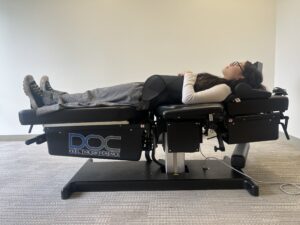Facet syndrome, also known as facet joint disease, facet arthritis, facet osteoarthritis or facet hypertrophy, is a painful condition that affects facet joints. It is believed to be one of the most common causes of lower back pain.
What Is Facet Syndrome?
Facet syndrome is a painful spinal condition that develops with age when facet joints are affected by degenerative or wear and tear changes.
Facet joints are plane joints between two adjacent vertebrae. Each spinal motion segment has two facet joints (left and right), which are richly innervated. They are synovial joints that are lined with cartilage and lubricated with synovial fluid. When healthy these joints glide and slide as the back moves, and protect from excessive rotation and flexion.
Over time, facet cartilage shred, become inflamed, and can break down. When this happens, nearby nerve endings are irritated and pain signals are triggered. These changes can affect the cervical, thoracic and lumbar spine.
Causes of Facet Syndrome
As a
Facet syndrome occurs in both men and women. It is most common in people between 40 and 70 years old, and the risk of developing is higher in those with arthritis and previous spine injuries.
Facet Syndrome Symptoms
Depending on which facet joints are affected by degenerative changes, symptoms differ. So according to the pain point, there are three types of facet syndrome:
Cervical Facet Joint Point
Cervical facet joint pain is felt in the neck, often at the base of the skull. This pain can radiate to one or both shoulders and/or arms and can be manifested as burning sensation. Patients often experience headaches and buzzing in the ear too.
Thoracic Facet Joint Point
Thoracic facet joint pain is less common than neck and lumbar pain. The pain is felt locally on the back, near the affected joints.
Lumbar Facet Joint Point
Lumbar facet syndrome is commonly present, the pain usually is felt over the affected joints, but it can radiate to the buttocks, hips, groin,
The pain is characterized as diffuse, dull pain directly over the spine, that can radiate to arms or legs, depending which segment is affected. It can be chronic or periodic, and often mimic the pain of disc herniation.
In many cases,
Patients with facet syndrome also have difficulty in twisting and bending. When cervical (neck) joints are affected, patients have to turn entire body to look left and right. For patients with lumbar facet syndrome have difficulty it is difficult to get up out of the chair. Typically there is more discomfort while leaning backward, than while leaning forward.
Numbness and muscle weakness are also present.
Diagnosis of Facet Syndrome
Setting diagnosis of facet syndrome can be quite complicated, as it often mimics other spine conditions. Diagnosis can be done only in during the acute episode when symptoms are presented.
The diagnostic process includes medical history, physical examination, imaging tests, and a facet joint injection.
Your doctor will ask you questions about the symptoms: describing the pain, where is pain located, if some activities aggravate
An imaging test, like X-ray and
Most definitive diagnosis of facet syndrome is when the facet joint injection is used. In this test, suspicious facet joints are injected with a small volume of local anesthetic and cortisone, relief of the pain is a positive result.
Explore these helpful resources to learn more:
Facet Joint Pain Treatment
The main goal in treating facet syndrome is to relieve the pain and inflammatio, and to improve mobility and strength. There are many options that can help to cope with the symptoms, but most of them only provide short-term relief.
Conservative Treatment for Facet Joint Pain
Conservative treatment of facet syndrome consists of a wide spectrum of methods that lead to relieving the pain and inflammation and easing daily activities. Not every method works for everybody. So, if you have facet syndrome it is important to searching until you find the right therapy for you.
Medications such as acetaminophen and NSAIDs (ibuprofen, ketoprofen) can help with reducing the pain and inflammation.
Putting hot or cold pads over the affected joint can reduce soreness. Cold pads also will reduce the inflammation, due to reduced blood flow in the area under them.
Proper exercises instructed by healthcare professional and good posture are very useful.
When neck is affected, restraining collar and cervical traction can bring relief.
Physical therapy and ultrasound therapy when practiced correctly have
Spinal Injection for Facet Joint Pain
Injection corticosteroid and local anesthetic in the facet joints leads to reducing the inflammation and pain. The relief usually lasts for several weeks or months.
Surgical Treatment for Facet Joint Jamming
Facet joint surgery is an option only when conservative treatments don’t work. Surgery for the facet joints usually consists of a fusion of the adjacent joints.
Chiropractic Care For Facet Syndrome
This is one of the conditions where a chiropractor can help the most. Chiropractors are trained in facet joint release technique. The treatment usually starts with muscle work to release muscle spasms. Next, the chiropractor will assess the severity of the condition and will determine where to make spinal adjustments, so it is not painful. In acute episodes, full symptoms relief is achieved in 4-6 treatments, and in more chronic cases, the number of treatments is extended.
To get to the root cause of pain and discomfort, schedule an initial consultation, including a comprehensive evaluation and first treatment.



